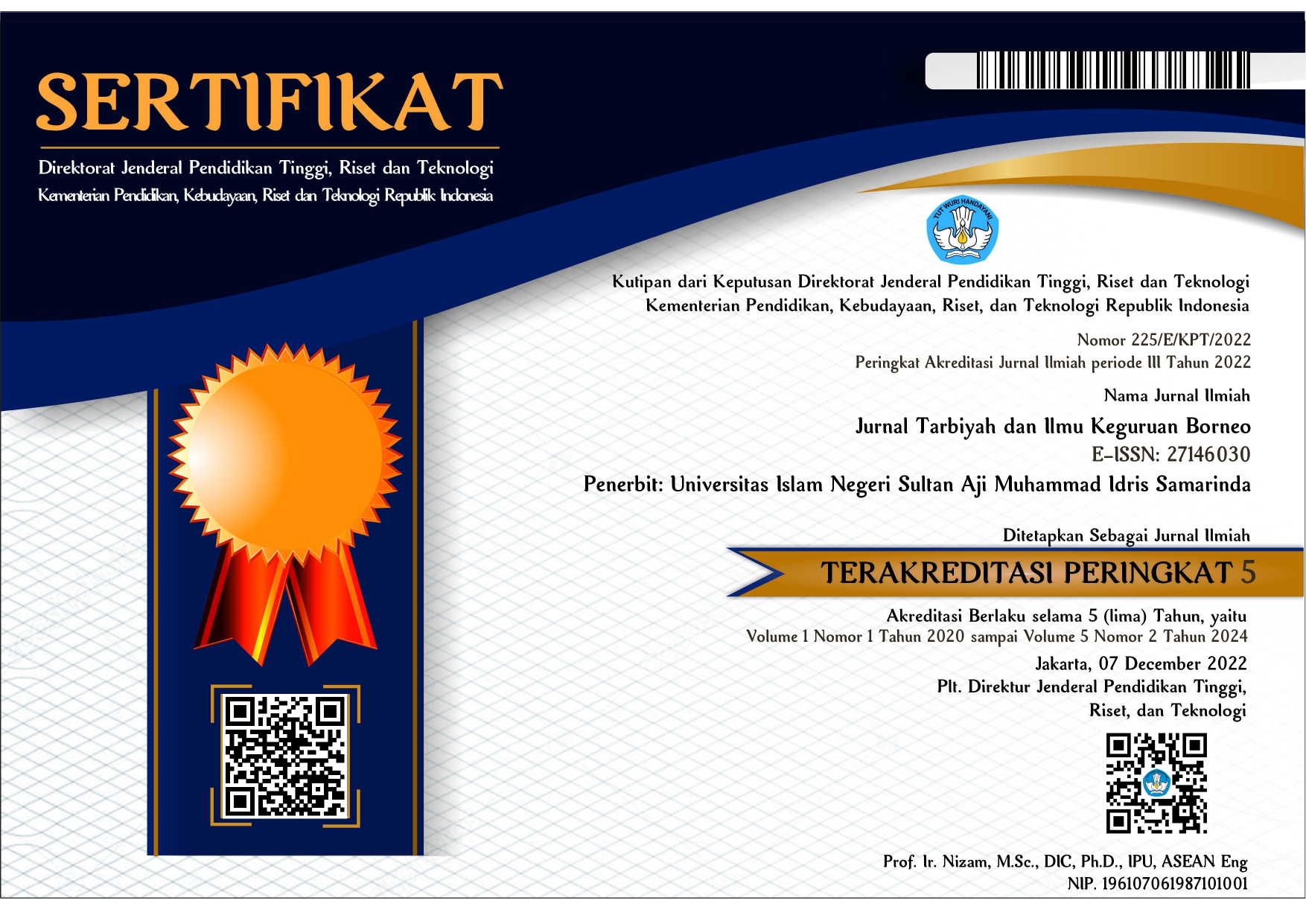Implementasi Pembinaan Muallaf Melalui Pendidikan Islam Di Kota Samarinda
Abstract
Based on the phenomena that occurred at Bina Mualaf Institute in Samarinda City, there were differences in improving the practice of Islam, including at the planning, implementation, and decision-making stages of deliberation and consensus among the converts. Therefore, this study aims to describe the strategy of Bina Mualaf Institute in planning the program for converting to Islam through daily, weekly, monthly, six-monthly, annual and various kinds of skills. Reality shows that religion does not belong only to the lower class but belongs to all levels of society without using the classification system. This research is qualitative with a case study approach. The subjects selected in this study were limited to the management of Bina Mualaf Institute for converting to Islam, converts to converts, and converts to Islam with the age limit criteria being 25 years of converts. The researcher chose Bina Mualaf Institute of Samarinda City based on the researcher's initial observations that there were some converts who returned to their previous religion. To get the data as a whole, the researcher used observation, documentation and interview techniques. While the data analysis technique, the researcher uses the Miles and Huberman technique in three stages, namely data condensation, data display, and verification. The data obtained will be tested through the persistence technique of observing source triangulation and technical triangulation. The results of this study revealed that; Planning for converting converts can be traced through daily, weekly, monthly, six-monthly and yearly recitations. The implementation carried out by Bina Mualaf Institute in coaching is at three location points, namely at the secretariat of Bina Mualaf of the Islamic Center Mosque, in sub-district of Loa Janan, and Cendarawasi Samarinda City.
References
Baderun and Rani, “Strategi Pembinaan Keagamaan Muallaf Dayak Meratus Kalimantan Selatan.”
Dokumentasi Lembaga Bina Maullaf kota Samarinda Tahun 2022
Fanani Indun, “Strategi Pemberdayaan Keagamaan Muallaf: Studi Kasus Pada Kelompok Kerja Penyuluh (Pokjaluh) Kementerian Agama Kabupaten Ponorogo” (PhD Thesis, Universitas Muhammadiyah Ponorogo, 2018).
Hafidz Muhdhori, “Treatmen Dan Kondisi Psikologis Muallaf,” JURNAL EDUKASI: Jurnal Bimbingan Konseling 3, no. 1 (2017): 16–39.
Hafidz Muhdhori, “Treatmen Dan Kondisi Psikologis Muallaf,” Jurnal Edukasi: Jurnal Bimbingan Konseling 3, no. 1 (2017): 16–39.
Hidayati, “Problematika Pembinaan Muallaf Di Kota Singkawang Dan Solusinya Melalui Program Konseling Komprehensif,” 2014.
Hidayati, “Problematika Pembinaan Muallaf Di Kota Singkawang Dan Solusinya Melalui Program Konseling Komprehensif,” 2014.
Imam Taulabi, “Volume I – Nomor 2, September 2016 - 32 -,” Jurnal Tribakti 27, no. September (2016): 285–301.
Imam, “Strategi Pembinaan Muallaf Di Masjid PITI Andre Al-Hikmah Wlahar Kulon, Patikraja, Banyumas,” 2021.
Indra Hidayat, “Konversi Agama Dan Permasalahannya Dalam Kehidupan Modern,” Al-Mursalah 2, no. 1 (2018).
Indun, “Strategi Pemberdayaan Keagamaan Muallaf.” 2018. 1-98.
Kurnial Ilahi and Jamaluddin Rabain, “Konversi Agama (Kajian Teoritis Dan Empiris Terhadap Fenomena, Faktor, Dan Dampak Sosial Di Minangkabau)” (Kalimetro Inteligensia Media, 2017).
Lathiffuddin Imam, “Strategi Pembinaan Muallaf Di Masjid PITI Andre Al-Hikmah Wlahar Kulon, Patikraja, Banyumas” (PhD Thesis, IAIN Purwokerto, 2021).
Mulyono, Abidin, and Dewi, “Proses Pencarian Identitas Diri Pada Remaja Muallaf,” 2002.
Ninin Kholida Mulyono, Zaenal Abidin, and Endah Kumala Dewi, “Proses Pencarian Identitas Diri Pada Remaja Muallaf” (PhD Thesis, Universitas Diponegoro, 2002).
Rahayu, “Muallaf Dalam Perspektif Alquran,” 2019. 1-88.
Samsinah Samsinah, “Strategi Komunikasi Penyuluh Agama Islam Dalam Pembinaan Muallaf Di Patambia Kabupaten Pinrang” (PhD Thesis, IAIN Parepare, 2020). 1-55.
Samsinah Samsinah, “Strategi Penyuluh Agama Islam Dalam Pembinaan Muallaf Di Patambia Kabupaten Pinrang” (PhD Thesis, IAIN Parepare, 2020).
Sri Hidayati, “Problematika Pembinaan Muallaf Di Kota Singkawang Dan Solusinya Melalui Program Konseling Komprehensif,” Jurnal Dakwah 15, no. 1 (2014): 111–36.
Sri Hidayati, “Problematika Pembinaan Muallaf Di Kota Singkawang Dan Solusinya Melalui Program Konseling Komprehensif,” Jurnal Dakwah 15, no. 1 (2014): 111–36.
Sri Ulfa Rahayu, “Muallaf Dalam Perspektif Alquran,” Al-I’jaz: Jurnal Kewahyuan Islam 5, no. 2 (2019).
Syaiful Hamali, “Dampak Konversi Agama Terhadap Sikap Dan Tingkah Laku Keagamaan Individu,” Al-Adyan: Jurnal Studi Lintas Agama 7, no. 2 (2012): 21–40.
Umin, “Bimbingan Islami Bagi Mualaf Di Mualaf Center Indonesia (MCI) Cabang Lampung.”
Yudi Muljana, “Dampak Pembinaan Dan Pendampingan Mualaf Terhadap Perilaku Keagamaan Mualaf Di Yayasan Masjid Al-Falah Surabaya” (PhD Thesis, IAIN Syekh Nurjati Cirebon, 2011).




.svg_2.png)















